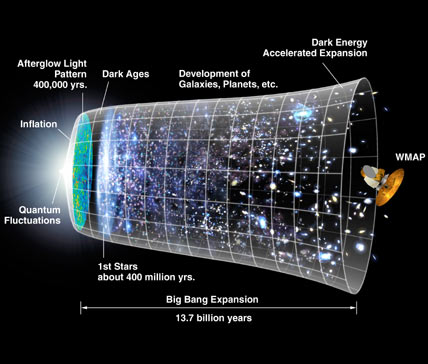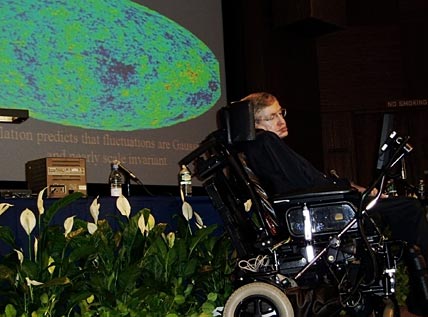Stephen Hawking’s last paper on cosmology, published posthumously, might solve the problem of eternal inflation, a theory that suggests our cosmos is but one in a sea of infinite universes.

NASA / WMAP
There's a lot of evidence to suggest that, just a tiny fraction of a second after the Big Bang, the infant universe went through a fantastic growth spurt. The phase itself lasted only a fraction of a second, but it’s responsible for the universe we see now. Even the particles that make up stars and humans alike were created from its energy.
The trouble is, according to most theories of cosmic inflation, the growth spurt never really stopped. Though our pocket of space, what we call our universe, might have stopped its exponential expansion, the overall universe never stopped stretching.
Now, in a paper published by Stephen Hawking (posthumously) and his colleague Thomas Hertog (KU Leuven, Belgium) in the Journal of High Energy Physics, the scientists turn that picture on its head, arguing that we need to rethink our universe’s beginnings. Applying quantum and string theory to a simplified mathematical model of the universe, Hawking and Hertog conclude that cosmic inflation isn’t eternal after all.
Eternal Inflation
Why do most cosmologists think that inflation is eternal? The idea behind inflation is that almost immediately after the Big Bang, our entire universe entered into a not entirely stable energy state known as a false vacuum. The term is a bit misleading, because what scientists mean by “vacuum” in this case is actually “ground state”; “false vacuum” is just another way of saying that the universe is in an elevated energy state. The negative pressure of this state causes all of space to expand exponentially quickly.
Obviously, our universe isn’t still in this growth spurt — otherwise we wouldn’t even be able to see neighboring galaxies. The expansion of space would have long since have spirited them out of sight. Somehow, at least our local universe had to come out of this phase.
Shortly after Alan Guth formulated the idea of inflation, scientists including Paul Steinhardt (then at University of Pennsylvania) and Alexander Vilenkin (Tufts University), figured out that quantum fluctuations could do the trick for ending the inflationary era. A pocket of space could spontaneously come out of inflation, settling into a relatively sedate phase of expansion. But, quantum fluctuations being random, inflation would stop here and there rather than everywhere at once. Meanwhile, far beyond what we can observe, space keeps inflating at an exponential rate. Even as quantum fluctuations cause other pockets of space to similarly come out of inflation, the universe as a whole would keep growing exponentially — forever.
If inflation is really eternal, then our cosmos is one of an infinite variety of universes (known as the multiverse), each following an infinite variety of physical laws.
A Finite Universe

Dan Falk
At least, that’s the conclusion cosmologists reach when treating quantum effects as small relative to a universe largely dominated by relativity. “But I have never been a fan of the multiverse,” Hawking said in an interview last fall. “If the scale of different universes in the multiverse is large or infinite the theory can’t be tested.”
Instead, Hawking and Hertog argue, relativity would break down in the early universe; only quantum theory applies. Treating the universe as a single, tiny particle, they compute its wave function: a single equation that describes all the possible states our universe could take.
In order to do this, they first simplify the math in some seemingly strange ways. First, they assume a simple universe, one without matter or energy, with an overall geometry that’s saddle-shaped. Of course, we don’t actually live in a universe without matter or energy, and the universe’s geometry appears to be flat as a sheet of a paper rather than saddle-shaped, but this is the starting point that many cosmologists take to work out new theories.
But that’s not all. They also assume that they can treat this universe as a hologram. Yes, really — it sounds weird, but basically what they’re doing is reducing three-dimensional equations into two-dimensional equations projected onto a surface. (It doesn’t mean our universe is a hologram, just that we can mathematically treat it like one.)
Rather than reducing a spatial dimension, though, what Hawking and Hertog remove is time. Relativity is no longer necessary in a timeless universe, and the pair could rely instead solely on quantum theory.
From there, Hawking and Hertog solve the equations and come to an astounding conclusion: the universe that emerges from inflation is finite. We still live in a multiverse, but now it’s one with limited possibilities.
However, Vilenkin urges caution in interpreting these results, noting that the simplified mathematical treatment, and the conclusions Hawking and Hertog derive from it, might not apply to our real, more complicated universe. “I am sure Thomas Hertog will try to go beyond this model,” Vilenkin adds, “but it is hard to tell how successful this is going to be.”
 8
8
Comments
Rod
May 5, 2018 at 8:28 am
"From there, Hawking and Hertog solve the equations and come to an astounding conclusion: the universe that emerges from inflation is finite. We still live in a multiverse, but now it’s one with limited possibilities." My observations - limited possibilities? Perhaps the multiverse then contains 10^500 different universes all with different natural laws or perhaps universes with no laws. Sounds like an effort to explain the origin of natural law in our universe because the big bang event does not create natural law or provides no answer for why we see natural law operating in our universe, e.g. Galilean moons orbiting Jupiter or helium detected recently in an exoplanet via spectroscopy. Somehow, natural law just fell out here, in the multiverse, something else went down and other laws popped out 🙂
You must be logged in to post a comment.
Peter Wilson
May 7, 2018 at 11:00 am
By offering to explain The Beginning, cosmologists have painted themselves into a corner. Creation of something-from-nothing requires the supernatural. Use of the G-word, however, is strictly taboo in scientific circles. So they cloak "It" in mathematics, giving the supernatural an air of respectability, and maintaining a veil of plausibility, on the premise of It being falsifiable. I don't see how this approach can end in success...
You must be logged in to post a comment.
Alan MacRobert
May 10, 2018 at 12:20 pm
> Creation of something-from-nothing requires the supernatural.
But then what created that supernatural creator? In other words, what made God? And if you posit that there can be an uncreated *anything*, then an uncreated universe is just as plausible as as uncreated God.
Even when I was about 10 years old this was an obvious puzzle to me and my friends. We decided there must be a bigger God who made our God, and a bigger one who made that one, and so on up forever (this was in Mormon country). Today such a series is called an "infinite regression." Does it apply to gods or universes? Take your pick!
You must be logged in to post a comment.
Raymond
May 11, 2018 at 4:29 pm
It's turtles all the way down!
You must be logged in to post a comment.
Peter Wilson
May 14, 2018 at 11:45 am
Not if you read the paper. Applying tensor string theory to a a heuristic model of the multi-verse in 10-dimensions, Hawking and Hertog have shown that the turtles may stop at 42...
You must be logged in to post a comment.
Rod
May 13, 2018 at 8:18 am
Okay, interesting comments about the origin of natural law we see operating in the universe. "Nature's laws and Nature's God" is not acceptable paradigm for many in science today. I recently watched a SCI program on how the Earth got its water narrated by Mike Rowe. At the end, the answer provided was "14 billion years and a whole lot of luck". So how does science explain the origin of natural law and physical constants in the universe allowing the Earth we live on to be very habitable? In my view the answer is the appeal to the natural law that "stuff happens" - this explains how we arrived on a very habitable Earth teeming with life and life arose via spontaneous generation from stuff. I am free to embrace Genesis 1:1, others can throw out Genesis 1:1 and go with "stuff happens" 🙂
You must be logged in to post a comment.
Rod
May 15, 2018 at 8:16 am
Okay, "the turtles may stop at 42.." So is this the min value here? 42 different universes that emerged after the big bang? What is the max value? 10E+500? I watched the SCI channel, "How the Universe Works", "Mystery of Spacetime" narrated by Mike Rowe. Quantum gravity is used to avoid the singularity before the big bang that General Relativity creates when we extrapolate back into an area <= Planck length in size for the beginning of our universe we see today. However, before our beginning, perhaps another universe collapsed and an infinite rebound cycle just continues in this version of the big bang. It seems quantum gravity allows for an infinite cycle of contraction and expansion with many different flavors of universes evolving over an infinite span of time. The origin of our physical laws and constants allowing Earth to be inhabited and teeming with life remains unanswered and not predicted by the math it seems. This winter I enjoyed viewing Rigel and its binary companion with my telescope. Somehow, after the big bang the Earth did not evolve at this star system because of the natural law that stuff happens 🙂
You must be logged in to post a comment.
IdPnSD
June 17, 2020 at 2:39 pm
“… the universe’s geometry appears to be flat as a sheet of a paper rather than saddle-shaped, but this is the starting point that many cosmologists take to work out new theories.” – It is a fundamental flaw in our science theories, which always start with assumptions. Assumptions are always invalid for both nature and engineering, and therefore can never be tested, because nature and engineering will automatically reject them making all theories to fail.
Newton’s first law failed, because it assumed: in the absence of any unbalanced force, which is never true, because gravity is always there everywhere in the universe. Quantum mechanics fails because its foundation, the uncertainty principle assumes: position and momentum are related by Fourier transform, which uses infinity. Both are false assumptions. Relativity assumes straight line which is nonexistent in nature. Such a science will never be able to explain life and the universe.
We must study Bible and Vedas carefully. They give the same answers for everything correctly and which can be and has been observed in nature. Take a look at the article for more details: https://www.academia.edu/38590496/A_COMPARISON_OF_MODERN_SCIENCE_WITH_VEDIC_SCIENCE
You must be logged in to post a comment.
You must be logged in to post a comment.